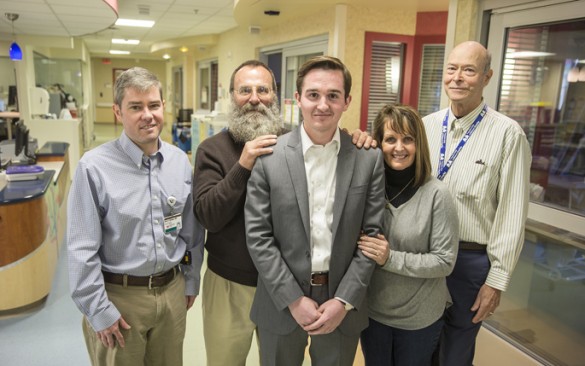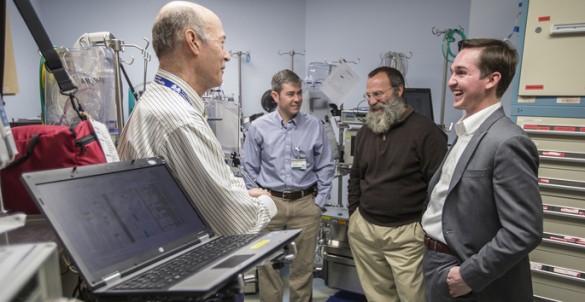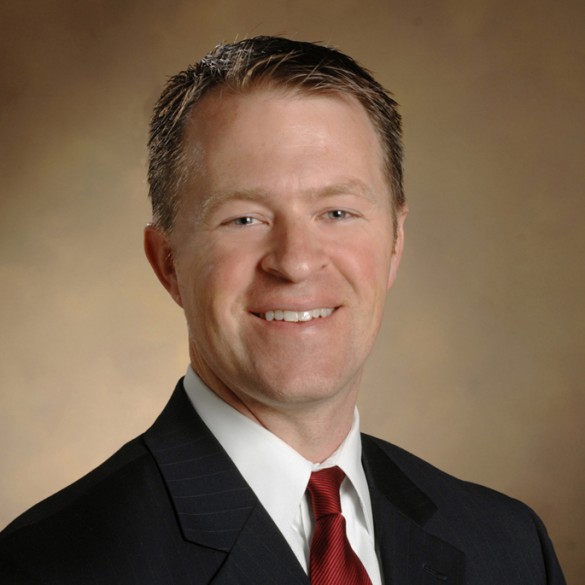
Eric Scelzi was a healthy 15-year-old boy who enjoyed soccer and competitive cycling. But in three days in 2011, he went from having a headache to fighting for his life.
Eric developed flu-like symptoms and contracted viral pneumonia, and was taken via Vanderbilt LifeFlight from an emergency room in Paducah, Kentucky, where his family lives, to Monroe Carell Jr. Children’s Hospital at Vanderbilt. He could barely breathe, and his kidneys were failing.
Today, Eric is a healthy 20-year-old man, thanks to a special machine at Vanderbilt that takes over for the lungs or heart when one or both fail to perform. It’s called extracorporeal membrane oxygenation (ECMO), and has been used on more than 960 patients at Vanderbilt since the ECMO program began 25 years ago. Children’s Hospital was the first in Tennessee to employ ECMO, and now the program is among the largest and most successful in the world, averaging 50 patients per year.
“It’s a resource that you don’t need that often, but when you need it, it makes a huge difference,” said John Pietsch, M.D., surgical director and founder of the ECMO program at Vanderbilt.
Scelzi’s family didn’t know anything about ECMO until they needed it. Eric was a healthy child.
His father, Jim Scelzi, said he was a boy who “toughed out” colds, just like the rest of the family. But something was different about Eric the day he went to urgent care, then the emergency room. He had trouble breathing and could barely walk.
Once at Vanderbilt, Eric spent 15 days on the ECMO machine, which artificially oxygenated his blood, then pumped it back into his body either through the arteries or veins. In comparison, the median time patients spend on ECMO is approximately 4.5 days, according to Pietsch.
Eric also ended up on dialysis because his kidneys were failing. His pneumonia was an aggressive MRSA variety that was destroying lung tissue, leading to several operations to control bleeding in his chest.

“I’d say that Eric was as sick as he could be,” said Brian Bridges, M.D., ECMO Medical Director. “I think we knew Eric was going to survive. The question was how good would the quality of his life be.”
Pietsch added, “The combination of the heavy sedation and the acuity of his illness as well as blood he had on his brain made it difficult to be certain, and we were worried about that.”
Eric has no memory of what happened while he was on the machine, as he was under medically induced sedation. But his mother does. The family spent most of those days at the hospital.
“He had lots of ups and downs,” she said. “It was like a roller coaster ride. I mean, some days by the end of the day, the only thing good was that he was still alive.”
Eric spent his 16th birthday on the ECMO machine. His lungs gradually improved, and he was eventually taken off sedation. But he was weak. “I mean, I couldn’t even change the remote on the TV,” he said.
Gradually, Eric could do the normal things again that he once took for granted, like brush his own teeth and take a shower.
He moved over to Vanderbilt Stallworth Rehabilitation Hospital for weeks of physical therapy.
Eric returned home and continued to improve. He’s graduated high school and is now studying finance at West Community and Technical College and is working as a financial adviser.
Jim Scelzi couldn’t be prouder of his son, and is grateful for Pietsch and Bridges and the Vanderbilt ECMO team.
“This is our only experience at a hospital, but, holy mackerel, if you’re going to choose one, I would definitely come here again,” he said. The care team was “very collegial… no silos or territories. I really felt like everyone was not out for themselves, they were out for him. And allowing me to see that was really important.”














